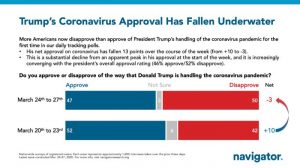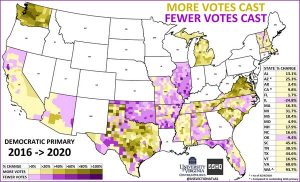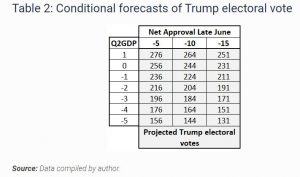Voters of a certain age should appreciate Charles Pierce’s Esquire article, “There’s an Awful Lot of ‘Cull the Herd’ Rhetoric Floating Around These Days: Ron Johnson joins the parade of people to whom my response is: You first.” Pierce writes, “I know we’re all slowing down and stuck in our houses, but I don’t think it’s time for U.S. senators to go all wiggy on existential questions. This is especially true in the case of Ron (Shreds of Freedom) Johnson, Republican of Wisconsin. He took to the pages of USA Today and encouraged us all to liberate ourselves through profound, patriotic, fatalistic gibberish…What is the senator getting at, exactly? There’s an awful lot of discreet “culling of the herd” realism floating around in the public rhetoric these days, and there’s also an occasional episode in which somebody seems to be putting it into practice, discreetly, in one way or another…Now that this particular president* has decided that a mere 100,000 to 200,000 dead will be a personal triumph on the scale of V-E Day, I find this attitude more than a little disturbing. My response remains unchanged: You guys first.”
New York Times columnist Thomas B. Edsall explains why “Covid-19 Is Twisting 2020 Beyond All Recognition: The coronavirus crisis will determine whether Trump is a one-term president, but it may reshape the social order far more.” Edsall’s article is loaded with anti-GOP talking points, including: “When the best-case scenario predicts 100,000 to 240,000 deaths, the pandemic reminds us just how important it is who holds the reins of power. This is especially the case when one crucial question will be whether widespread suffering, panic and economic collapse will destabilize the American political system and the fragile consensus-based social order that underpins it, both of which have been under strain for some time.” Edsall quotes Jonathan Haidt, a professor of psychology at N.Y.U.: “If we had good leadership — a president who could unify the country and turn our shared adversity into social solidarity, trust, and cooperation, then we could look to past national crises such as World War II and the boost it gave to social capital…We don’t have that. In fact, a marker of our political sickness is that taking the virus seriously has become itself a marker of tribal identity.”
However, Edsall also quotes UNC political scientist Marc Hetherington, who observes, “that “this moment holds the potential to resuscitate negative feelings that Americans have about government…If the government actually succeeds in keeping the carnage to a minimum, it is unlikely to change much. Americans already think government can do this. If, however, the government doesn’t succeed — and I think there is every reason to think it will struggle with these problems — it has the potential to further undermine trust in government. People already don’t trust it to redistribute money and provide certain services, which is bad. If they come to think it is not competent to keep us safe, it will be even worse, much worse…Republicans have internalized what used to be just a political strategy, which increases the chances that government will fail.” That cynical approach to campaigning seems to have infected their approach to governing. In 2016, the party nominated a complete political amateur, pointing up just how little governance means to the party. And, of course, Trump has failed to fill vacancies in key areas like the C.D.C., disbanded the pandemic task force in the N.S.C., and all sorts of other stuff.” Edsall add, “The result, Hetherington wrote, is a government “characterized by poor leadership at the cabinet level and hollowed out expertise at the department level,” sharply increasing the “chance that government simply can’t come through right now.”
Another potent observation unearthed by Edsall, this one by M.I.T. economist David Autor, who notes that it would be “easy to tell a story in which this episode causes Americans to remember that their government is indispensable for marshaling expertise, coordinating emergency measures, guarding public safety, serving as an insurer of last resort, calming financial markets, and generally shepherding its citizens through an extraordinarily challenging time.” However, Autor adds, “After four decades of successful Republican effort to starve the U.S. government of resources and demonize its experts, our government is in fact less competent, less well prepared, and less agile than it used to be. Perhaps this event would have restored our faith in government were the government deserving of that faith. The picture is mixed at best, so far.”
You may have heard some progressive grumbling that Democratic front-runner Biden is being eclipsed by NY Governor Cuomo’s excellent television presentations addressing the coronavirus crisis. But there’s no good reason why Biden should be the only Democrat presenting an image of compassion and competence, in stark contrast to Trump’s constant fumbling. In fact, the more Democratic leaders who project an image of responsible, well-informed leadership, the better it is for Democratic candidates for all offices, not just the presidency. At The Daily Beast, Matt Lewis weighs in and notes, “Joe Biden should social distance even more,” Lewis writes. “Citing a decades-old observation called the Feiler faster thesis, my former colleague Mickey Kaus recently argued that news cycles have sped up and that humans can process information quicker than most people realize. “Biden can wait until September, or whenever the conventions are, and then, he can gin up a huge publicity ‘Biden for president’ campaign,” Kaus said. “He doesn’t have to be omnipresent in our attention now in order to do that, then.” Lewis suggests Biden should “reemerge tanned and rested after Labor Day…Laying low may be Joe Biden’s best strategy—and it’s one that wouldn’t be possible were it not for social distancing.”
At FiveThirtyEight, Nathaniel Rakich writes that “the biggest Senate news of the last couple months came in the longer-shot Democratic pick-up opportunity of Montana, where Gov. Steve Bullock’s entry has shaken up the race. Bullock was considered to be the only Democrat who could put this red state in play, and his announcement caused nonpartisan handicappers to move the race from “Solid Republican” to “Lean Republican.”…According to Morning Consult, Bullock has a +21 net approval rating (approval rating minus disapproval rating) and at least 83 percent of Montanans are able to form an opinion of him (approval rating plusdisapproval rating). This gives him a leg up against incumbent Republican Sen. Steve Daines (who has just a +16 net approval rating and at least 78 percent name recognition, according to the same poll).”
Rakich also notes that “handicappers still rate Arizona as a toss-up, but there’s an increasingly strong argument that Democrats are actually favored despite the state’s Republican lean. Five polls of Arizona’s U.S. Senate race have been conducted so far in March, and Democrat Mark Kelly led Republican Sen. Martha McSally in all five. His average lead was 7 percentage points…Even a small systematic polling error in Arizona could mean that McSally is actually ahead (most of those Kelly leads are within the margin of error). However, Kelly also has the advantage of being a monster fundraiser — he took in more than $20.2 million in 2019. McSally raised only $12.6 million.”
“In North Carolina,” Rakich adds, “former state Sen. Cal Cunningham, who had the support of the DSCC, won the Democratic primary with 57 percent of the vote. That sets up a close general election with Republican Sen. Thom Tillis: A survey by Democratic firm Public Policy Polling claims Cunningham is ahead, while Tillis’s pollster gave the incumbent the lead.” NC’s other Republican Sen. Richard Burr is getting roundly slammed for his insider trading shenanigans. But he is not up for re-election this year, like Tillis. Here’s one of Cunningham’s ads:











